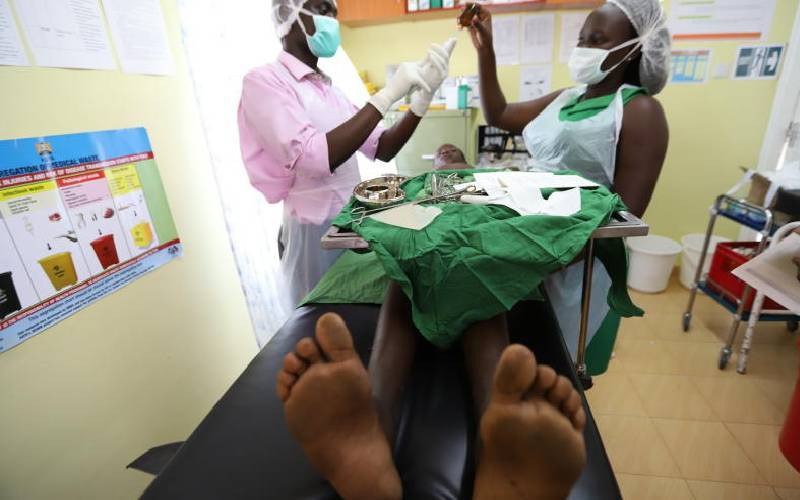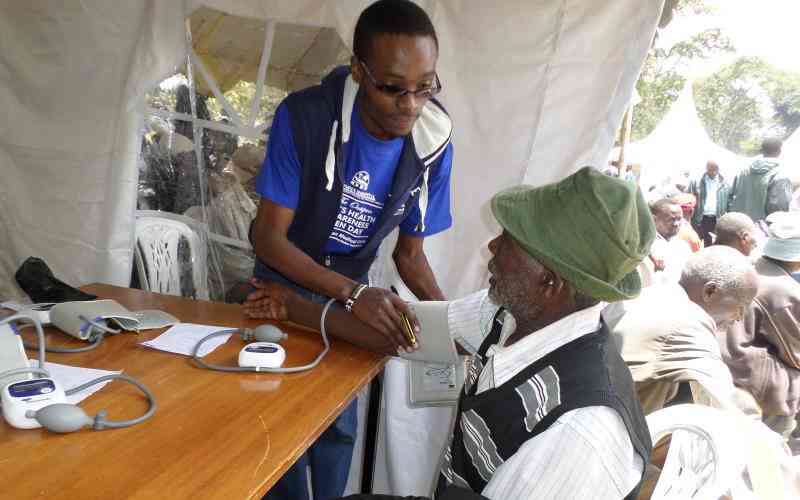
It is a common legend among some communities, especially the Akamba, to hear that the last stages of a witch's life are marked by the slipping out of her womb through the vagina.
Unknown to many, however, pelvic prolapse is very common, and there is so much one can do to help this problem. Although there's a lack of clear local statistics, according to National Centre for Biotechnology Information (NCBI), up to 50 per cent of women between ages 50 and 80 experience a degree of pelvic organ prolapse.
Pelvic prolapse is highly ignored, with much focus directed towards the devastating effect of obstetric fistulas. However, according to Dr Khisa Weston Wakasiaka, obstetrician and gynaecologist at the Hurlingham Family Health Clinic, many women are at risk for pelvic organ prolapse, a more severe condition that affects as many, if not more people, than fistulas.
According to Dr Khisa, the pelvic muscles and tissues hold up the pelvic organs and prevent them from sagging. The pelvic organs include the uterus, bladder, cervix, vagina, and rectum.
A prolapse happens when the pelvis muscles, tissues and ligaments can no longer support these organs because they're damaged or weak. This causes one or multiple pelvic organs to slip out of place and press into or out of the vagina.
"Pelvic organ prolapse (POP) is a gynaecological condition where the pelvic organs bulge or sag into the vagina due to muscular or ligament weakness," says Dr Khisa.
The most common type, he says, is the dropped bladder. It happens when the bladder drops into or out of the vagina.
The second most common type is when the rectum protrudes into or out of the vagina.
The last is the dropped uterus, which happens when the uterus protrudes into or out of the vagina. Uterine prolapse is sometimes associated with small intestine prolapse, where a part of the small intestine bulges into the vagina.
Most prolapses require medical treatment, but minor ones can resolve by themselves.
"Treatment options include vaginal pessaries, devices inserted into the vagina to secure the organs up, or surgery to stitch the organs in place," says Dr Khisa.
Pelvic floor muscle therapy is another treatment option where a physical therapist guides the patient to do exercises to help strengthen and maintain the pelvic floor muscles.
"We also recommend a change of diet to help with bowel movements. For example, foods with fibre help prevent constipation and straining during bowel movements," says Dr Khisa.
Surgery to close the vagina is also a treatment option, but this surgery is only an option for women who don't plan to have or who no longer have vaginal intercourse.
However, according to medical journals, up to 30 per cent of these surgeries fail.
"Surgery is not a quick fix and often fails, especially if the person is active. It tends to be most successful in older women,' says Dr Khisa, adding "if surgery is needed, then a good, slow rehabilitation plan is crucial."
Other symptoms of pelvic organ prolapse include feeling or seeing a profusion or "something coming out" of the vagina, discomfort, pain, or fullness in the pelvis, that gets worse with exertion like coughing, standing, having sex or as the day progresses, leaking urine (incontinence) or difficulties having a bowel movement.
Risk factors include vaginal childbirth, which can strain the pelvic floor, with multiple vaginal childbirths raising the risk for pelvic organ prolapse later in life.
"You can get a prolapse even if you've never had children or a caesarean delivery," says Dr Khisa.
Long-term pressure on the abdomen, including pressure from obesity, chronic coughing, giving birth to a baby weighing more than 3.8kg or straining during bowel movements and ageing are some risk factors.
Loss of the female hormone oestrogen during and after menopause can also raise the risk for pelvic organ prolapse.
"Oestrogen supports muscle integrity. Loss of it can weaken the muscles which support these organs," says Dr Khisa.
Family history is also a risk factor.
Physiotherapy and pelvic floor exercises such as Kegels can prevent and also help improve symptoms in up to 70 per cent of cases.
 The Standard Group Plc is a multi-media organization with investments in media platforms spanning newspaper print
operations, television, radio broadcasting, digital and online services. The Standard Group is recognized as a
leading multi-media house in Kenya with a key influence in matters of national and international interest.
The Standard Group Plc is a multi-media organization with investments in media platforms spanning newspaper print
operations, television, radio broadcasting, digital and online services. The Standard Group is recognized as a
leading multi-media house in Kenya with a key influence in matters of national and international interest.











